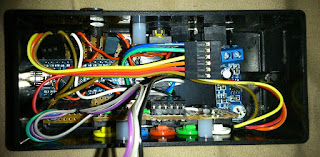Building The Casduino
The main board for the Casduino is very similar to the MarkII board but as I had a specific project case in mind the dimensions needed to be changed.
I had used an Evatron PPN Case in another project and wanted to use one for this to make a more compact and stylish product however the internal dimensions would make things a little more tricky.
Although the actual board design in mine is slightly different I feel that the following one should give the best fit.

The only difference I would make to the design is add right angled pins for the GND and VCC connectors on the right of the board. Also I soldered the Arduino Nano directly to the board as adding a DIL socket would just make it more difficult to fit in the Case
Rather than the usual buttons I ordered some with different coloured caps, again to give a more polished look.
Here is a template of how to cut out the hole for the LCD (Thanks to spcbm from Amibay for his template for the Tapuino)
A template for where to drill the holes for the front.
These are the alterations I made to the SD card.
This is how the final product looked.
Hopefully we will be able to alter the software so that a version can be uploaded to the Arduino Nano for whichever 8-bit machine you use.












greetings, I have already tried the casino and goes perfectly, I have not even put the lowpass filter, without it it has worked perfectly.
ReplyDeleteI would like to know if there is possibility to play wav file to play with other systems, Espectrum, Amstrad, Electron, ORIC, etc ...
a greeting.
For Spectrums with built in tape player and Amstrads you will need to modify the so they have a 3.5mm port and also there may need so experimenting to find the right frequency. However we are working on getting the cadsduino to see if it will play PZX files.
DeleteAndrew has conversion software for UEF files for the Electron and BBC which I will upload soon.
The lowpass is needed for when you play wavs but not needed if you play .CAS files.
hello again, the wav file reads the casino, I ask because I made a conversion of .CAS to .WAV in casstoll of msx, and would not correctly reproduce the casduino. A greeting.
DeleteIf you have built a Casduino then you do not need to convert a .CAS to .WAV as the Casduino software does that automatically.
ReplyDeleteIf you want to play .Wavs then you need to download my special version of CAS2WAV which outputs the .WAV at 14400Hz which is a frequency that the Arduitape can play successfully and the MSX can hear. Due to the lack of a hardware audio decoder the Arduitape can only play back .Wavs of up to 22000 Hz but each computer may need a specific frequency below that to be able to register the input.
If you are using designs from someone, you should mention where they come from.
ReplyDeleteI made the templates for the holes in the Tapuino project on Amibay
spcbm on Amibay
Done.
DeleteNice article great post comment information thanks for sharing
ReplyDeleteทองดีฟันขาว